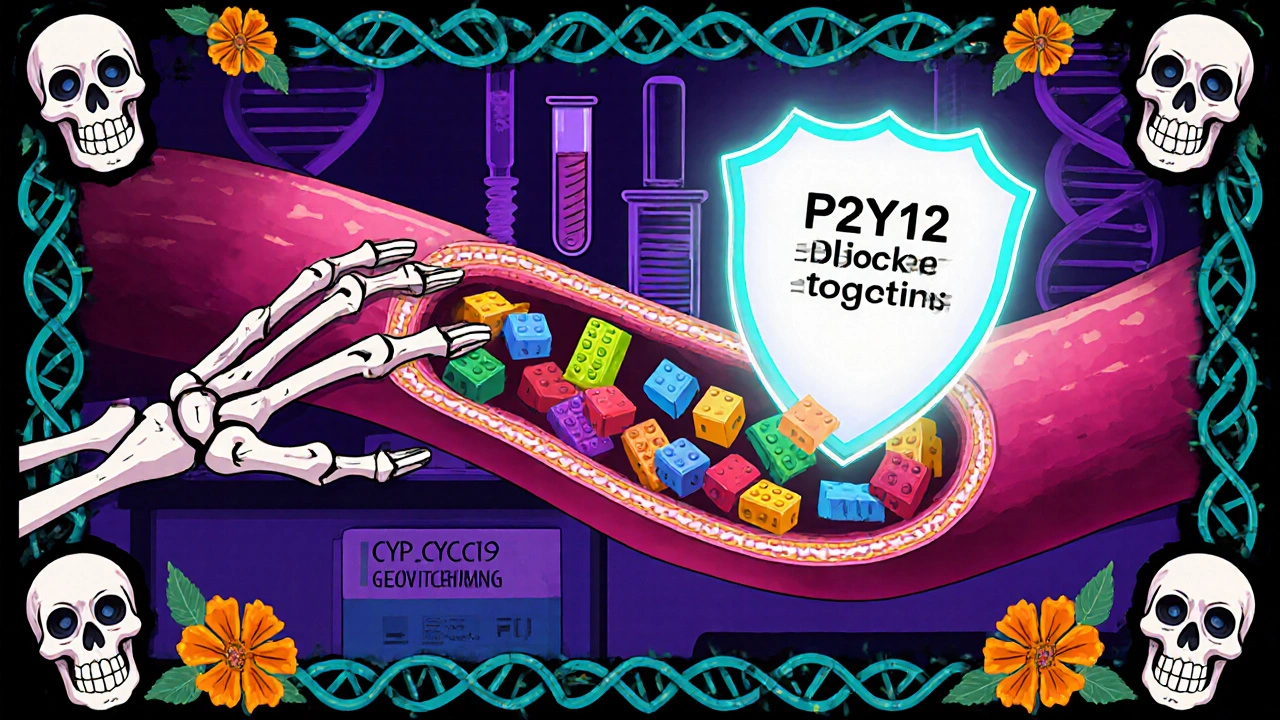Clopidogrel Adherence Calculator
Your Adherence Assessment
Calculate how well you're taking your clopidogrel as prescribed. Consistent use significantly reduces your risk of heart attacks and strokes.
Your Adherence Score
When doctors prescribe Clopidogrel is a tablet that blocks platelets from clumping, reducing the risk of heart attacks and strokes, patients often wonder what daily life will look like on the medication. This guide follows a typical patient’s experience, explains the science in plain language, and offers hands‑on advice for staying safe and comfortable.
Key Takeaways
- Clopidogrel works by inhibiting Platelet aggregation - the process that makes blood clot.
- It’s commonly prescribed after Percutaneous coronary intervention (PCI) or when you have a stent.
- Genetic differences in the enzyme CYP2C19 can affect how well the drug works.
- Common side effects include bruising, mild stomach upset, and rare but serious bleeding.
- Adherence strategies - pill boxes, reminders, and routine check‑ins - dramatically lower the risk of a cardiovascular event.
Understanding How Clopidogrel Works
The medicine belongs to the antiplatelet therapy family. Think of platelets as tiny bricks that can stick together to seal a wound. In people with heart disease, those bricks sometimes form clots inside arteries, blocking blood flow. Clopidogrel blocks a specific receptor called P2Y12 on the platelet surface, preventing the bricks from locking together.
This action is different from Aspirin, which reduces clotting by inhibiting a different pathway. Because they target separate mechanisms, doctors sometimes combine both drugs for stronger protection, especially after a stent is placed.
Why Doctors Prescribe It - The Typical Scenarios
Most patients start clopidogrel after one of these events:
- A heart attack (myocardial infarction) where the coronary artery was blocked.
- A stroke caused by a clot in a brain‑feeding artery.
- Undergoing Percutaneous coronary intervention (PCI), often followed by placement of a Stent. The metal scaffold can attract platelets, so the drug keeps the stent clear.
In each case, the goal is the same: keep blood flowing long‑term and avoid another life‑threatening clot.

Starting the Medication - What to Expect in the First Weeks
Most doctors begin with a 75mg dose once a day. Some specialists may load a higher dose (300mg) the first day after a heart attack, then drop to maintenance. The tablet is taken with or without food, but swallowing it with water helps avoid stomach irritation.
Within a few days, you might notice mild side effects:
- Minor bruising or easy bleeding from cuts.
- Slight nausea or indigestion.
- Rarely, a rash or itching.
These usually fade. If you experience persistent bleeding, dark stools, or sudden severe headache, contact your clinician immediately - these can signal a more serious bleed.
Managing Side Effects and Safety Tips
Because clopidogrel thins the blood, safety comes first when you’re doing everyday activities:
- Brush and floss gently. Use a soft‑bristled toothbrush and avoid aggressive flossing to prevent gum bleeding.
- When shaving, use an electric razor or a single‑edge blade to minimize cuts.
- Avoid high‑impact sports (e.g., rugby, skiing) unless cleared by your doctor.
- Carry a medication card that lists clopidogrel, dosage, and emergency contact.
Over‑the‑counter pain relievers like ibuprofen can increase bleeding risk. If you need pain relief, opt for acetaminophen and always check with your pharmacist.
Genetics, Drug Interactions, and the Role of CYP2C19
Not everyone processes clopidogrel the same way. The liver enzyme CYP2C19 converts the pro‑drug into its active form. About 30% of people carry a “poor metabolizer” variant, which means the drug is less effective.
Doctors may order a genetic test if you have a history of clots despite therapy or if you’re planning a major procedure. If you’re a poor metabolizer, alternatives like prasugrel or ticagrelor might be recommended.
Other medications can interfere with CYP2C19:
- Proton‑pump inhibitors (omeprazole, esomeprazole) - switch to pantoprazole if you need acid control.
- Selective serotonin reuptake inhibitors (SSRIs) - discuss dosage adjustments with your psychiatrist.
Always give your prescriber a full medication list, including supplements and herbal products such as ginkgo or garlic, which can also affect clotting.

Lifestyle Adjustments and Staying Adherent
Consistency is the biggest factor in preventing another cardiovascular event. Here are proven tricks that patients use daily:
- Set a reminder. Use your phone alarm or a smartwatch notification at the same time each day.
- Keep a weekly pill organizer. Place Sunday’s dose in the top compartment so you see it first.
- Link the dose to a routine - e.g., after brushing your teeth in the morning.
- Schedule quarterly blood‑work appointments. Seeing your lab results reinforces the habit.
- Involve a family member or partner. A simple “Did you take yours?” check‑in can catch missed doses.
Beyond the pill, adopt heart‑healthy habits: a Mediterranean‑style diet, regular moderate exercise (30minutes walking most days), and smoking cessation. These amplify the protective effect of clopidogrel.
When to Talk to Your Doctor
Even with careful management, there are moments you should call the clinic:
- Unexplained bruising larger than a penny or bleeding that lasts longer than a few minutes.
- Black or tarry stools - a sign of gastrointestinal bleeding.
- Sudden vision changes or severe headache - possible intracranial bleed.
- Planning surgery, dental extraction, or any invasive procedure - you’ll likely need a temporary pause.
Never stop the medication abruptly without medical advice; the protective effect fades within days, increasing the risk of a clot.
Frequently Asked Questions
Can I take clobetasol with clopidogrel?
Clobetasol is a topical steroid and does not affect blood clotting, so it is safe to use alongside clopidogrel.
How long will I need to stay on clopidogrel after a stent?
Most guidelines recommend at least 12 months of dual antiplatelet therapy (clopidogrel plus aspirin) after a drug‑eluting stent, then continue clopidogrel alone based on your doctor’s risk assessment.
Is it safe to travel by plane while on clopidogrel?
Yes, air travel is safe. Just keep your medication in your carry‑on, stay hydrated, and move your legs occasionally to avoid blood pooling.
What should I do if I miss a dose?
Take the missed tablet as soon as you remember, unless it’s almost time for the next dose. In that case, skip the missed one and resume the regular schedule - don’t double up.
Can foods like grapefruit affect clopidogrel?
Grapefruit mainly interacts with drugs metabolized by CYP3A4. Clopidogrel relies on CYP2C19, so grapefruit is not a major concern, but it’s still wise to keep a balanced diet.
Living with clopidogrel isn’t about giving up the things you love; it’s about making small, informed tweaks that keep your heart safe for the long run. By understanding how the drug works, watching for side effects, and building reliable habits, you can stay active, confident, and in control of your health journey.
Emily (Emma) Majerus
October 17, 2025 AT 13:35Great tipz! Keep that pill box ready and you’ll be golden.
Virginia Dominguez Gonzales
October 24, 2025 AT 01:08Embarking on the clopidogrel journey feels like stepping onto a tightrope, but you’ve got a safety net of knowledge now. Every morning when you pop that 75 mg tablet, picture it as a tiny guardian patrolling your arteries. Remember the first few days may bring a little bruise here or a mild tummy flutter there, and that’s perfectly normal. If a cut starts to bleed longer than a minute, treat it as a red flag and call your doctor without hesitation. Linking your dose to a daily habit-like brushing your teeth-turns medication into a reflex. A pill organizer isn’t just a box; it’s a visual promise you’ve made to yourself. Staying hydrated, especially on flights, keeps blood flowing smoothly and reduces the chance of clotting. Avoid ibuprofen like the plague; let acetaminophen be your go‑to for aches. When you shave, choose an electric razor; the less you slice, the better your bleeding risk stays low. If you ever need surgery or a dental extraction, a brief pause in therapy is standard-don’t panic. Genetic testing for CYP2C19 can unveil whether you’re a poor metabolizer, guiding doctors toward alternative meds. Keep a card in your wallet that lists clopidogrel, dosage, and emergency contacts; it’s a lifesaver in a hurry. Involving a family member or partner in your routine adds an extra layer of accountability. Adopt a Mediterranean diet, walk daily, and say no to smoking; these lifestyle tweaks amplify the drug’s power. Above all, trust the process, stay vigilant, and celebrate each symptom‑free day as a victory.
Carissa Padilha
October 30, 2025 AT 12:41Oh sure, they want you to swallow a little platelet‑blocking tablet and think you’re safe, but have you ever wondered who’s really profiting from the endless prescription cycle? The pharma giants love a chronic user; they push clopidogrel as if it’s the only way, while keeping alternative natural blood‑flow tricks hidden. Some say the CYP2C19 testing is just a way to sell more expensive genotyping kits, not to improve outcomes. And those “rare serious bleedings” they warn about? Probably under‑reported to keep the drug’s image shiny. If you’re skeptical, keep an eye on the fine print and maybe explore diet‑based platelet reducers-just saying.
Richard O'Callaghan
November 6, 2025 AT 00:15I noticed you mentioned dental work and the need to pause clopidogrel, and I have to say it feels like a sneaky reminder that the system wants you to be glued to appointments. It’s funny how the same doctors who prescribe the drug also schedule the next check‑in, right? Anyway, just make sure you have that medication card handy – you never know when a nurse will ask you to prove you’re on something.
Katie Henry
November 12, 2025 AT 11:48Dear fellow traveller on the clopidogrel pathway, it is incumbent upon us to observe the highest standards of adherence and vigilance. I exhort you to employ a chronometer of impeccable precision, such as an automated alarm, to ensure the quotidian ingestion of your prescribed dosage. Furthermore, I recommend the procurement of a meticulously organized pill compartment, thereby obviating any potential lapse in therapy. May your endeavors be crowned with sustained cardiovascular health and unremitting compliance.
Chris Beck
November 18, 2025 AT 23:21We brits know best-stop listening to foreign drug promos!!
Sara Werb
November 25, 2025 AT 10:55Do you really think a tiny pill can keep your heart from exploding??? The government *doesn't* want you to know the truth about blood‑clot conspiracies!!! They hide the side‑effects and push you to swallow more!!
Winston Bar
December 1, 2025 AT 22:28Meh, another pill, same old story.
Russell Abelido
December 8, 2025 AT 10:01Wow, that was a marathon of good advice! 😃 You really laid out the entire battlefield of daily coping, from the humble pillbox to the heroic cardio‑friendly diet. I especially love the visual of the tablet as a guardian-makes the routine feel epic. Your reminder about genetic testing is spot‑on; many folks overlook that hidden factor. Keep crushing it, and thanks for the pep talk!